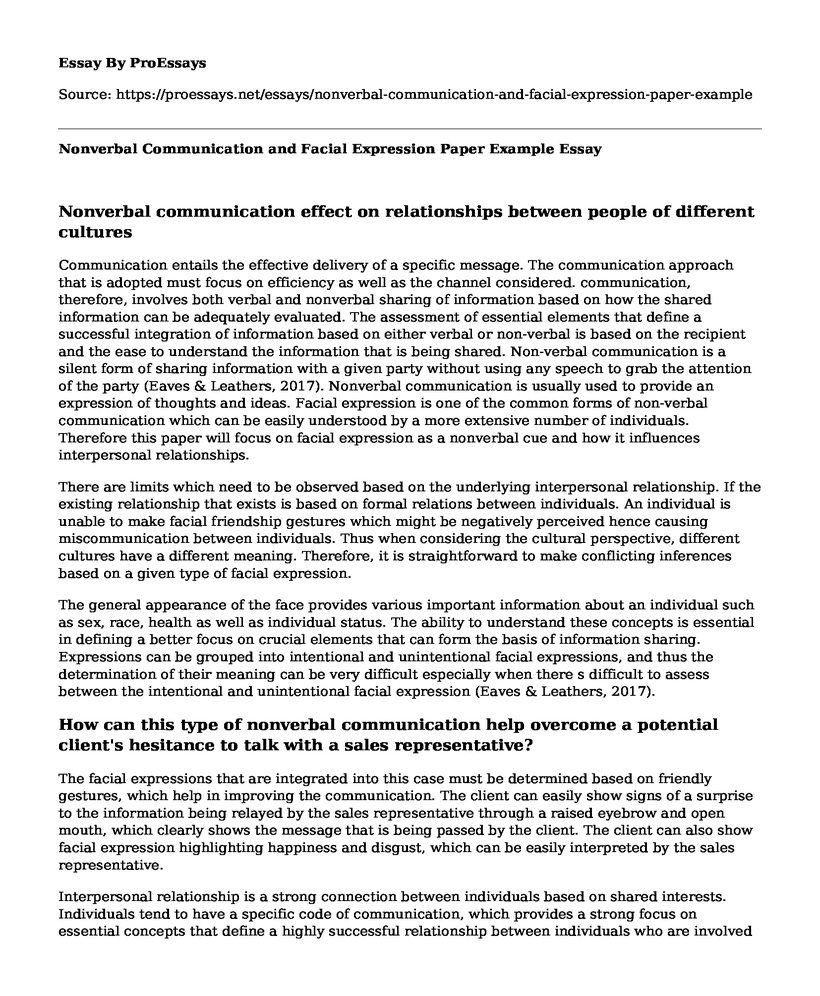Nonverbal communication effect on relationships between people of different cultures
Communication entails the effective delivery of a specific message. The communication approach that is adopted must focus on efficiency as well as the channel considered. communication, therefore, involves both verbal and nonverbal sharing of information based on how the shared information can be adequately evaluated. The assessment of essential elements that define a successful integration of information based on either verbal or non-verbal is based on the recipient and the ease to understand the information that is being shared. Non-verbal communication is a silent form of sharing information with a given party without using any speech to grab the attention of the party (Eaves & Leathers, 2017). Nonverbal communication is usually used to provide an expression of thoughts and ideas. Facial expression is one of the common forms of non-verbal communication which can be easily understood by a more extensive number of individuals. Therefore this paper will focus on facial expression as a nonverbal cue and how it influences interpersonal relationships.
There are limits which need to be observed based on the underlying interpersonal relationship. If the existing relationship that exists is based on formal relations between individuals. An individual is unable to make facial friendship gestures which might be negatively perceived hence causing miscommunication between individuals. Thus when considering the cultural perspective, different cultures have a different meaning. Therefore, it is straightforward to make conflicting inferences based on a given type of facial expression.
The general appearance of the face provides various important information about an individual such as sex, race, health as well as individual status. The ability to understand these concepts is essential in defining a better focus on crucial elements that can form the basis of information sharing. Expressions can be grouped into intentional and unintentional facial expressions, and thus the determination of their meaning can be very difficult especially when there s difficult to assess between the intentional and unintentional facial expression (Eaves & Leathers, 2017).
How can this type of nonverbal communication help overcome a potential client's hesitance to talk with a sales representative?
The facial expressions that are integrated into this case must be determined based on friendly gestures, which help in improving the communication. The client can easily show signs of a surprise to the information being relayed by the sales representative through a raised eyebrow and open mouth, which clearly shows the message that is being passed by the client. The client can also show facial expression highlighting happiness and disgust, which can be easily interpreted by the sales representative.
Interpersonal relationship is a strong connection between individuals based on shared interests. Individuals tend to have a specific code of communication, which provides a strong focus on essential concepts that define a highly successful relationship between individuals who are involved within a given setting. Interpersonal relationships develop gradually based on the existing relationship between individuals. Facial expression is essential in defining the level of understanding between individuals. Individuals can make different facial expressions depending on the type of interpersonal relationship the exists between individuals (Burgoon, Guerrero & Floyd, 2016).
Importance of facial expression in making the first impression
Communications are defined by the critical focus on the fact that individuals involved can have a successful conversation based on the existing common interests. Facial expression is fundamental in making the first impression because it can clearly show the level of satisfaction or dissatisfaction. Therefore based on the information provided it is essential to build a successful determination regarding the next step to undertake to have successful communication. Persuasive communication requires facial expression input to elaborate on the seriousness of the communication being undertaken. Interpersonal relationship is defined by the level of interaction between individuals hence making better decisions involve strategic consideration of essential processes that outline successful development (Tracy, Randles, & Steckler, 2015).
References
Burgoon, J. K., Guerrero, L. K., & Floyd, K. (2016). Nonverbal communication. Routledge.
Eaves, M., & Leathers, D. G. (2017). Successful nonverbal communication: Principles and applications. Routledge.
Tracy, J. L., Randles, D., & Steckler, C. M. (2015). The nonverbal communication of emotions. Current opinion in behavioral sciences, 3, 25-30.
Cite this page
Nonverbal Communication and Facial Expression Paper Example. (2022, Jul 08). Retrieved from https://proessays.net/essays/nonverbal-communication-and-facial-expression-paper-example
If you are the original author of this essay and no longer wish to have it published on the ProEssays website, please click below to request its removal:
- Communication Case Studies for Health Care Professionals Paper Example
- Essay Sample on Interpersonal Communication
- Essay Example on Substance Abuse in Adolescents: Impact of Nicotine
- Influence of Self-Esteem, Personality on Social Media Interaction - Essay Sample
- Legal and Ethical Issues With Surrogacy Essay
- Race & Gender: Two Factors in Governmental Inequality - Research Paper
- Essay on Verbal Rumination in the Workplace: Negative Impacts & Solutions







